This step by step diy woodworking project is about a 14×24 outdoor lean to pavilion plans. These designs offer ample space for gatherings and events while incorporating a stylish sloping roofline, adding an aesthetic appeal and practical shelter to your outdoor oasis. Delight in the grandeur of open spaces, where laughter echoes beneath the gentle slope of the roof, creating a haven for unforgettable moments with loved ones. This garden gazebo blends elegance and functionality, beckoning you to embrace the beauty of nature while reveling in the warmth and joy of shared experiences.
The roof for this pavilion has a pitch of 4:12. Make sure you take a look over the local building codes, so you comply with the regulations. Take a look over the rest of our woodworking plans, if you want to get more building inspiration. Check out the Shop, as well, for full list of Premium Plans.
When buying the lumber, you should select the planks with great care, making sure they are straight and without any visible flaws (cracks, knots, twists, decay). Investing in cedar or other weather resistant lumber is a good idea, as it will pay off on the long run. Use a spirit level to plumb and align the components, before inserting the galvanized screws, otherwise the project won’t have a symmetrical look. If you have all the materials and tools required for the project, you could get the job done in about a day.
Projects made from these plans
14×24 Lean to Pavilion Plans – PDF Download
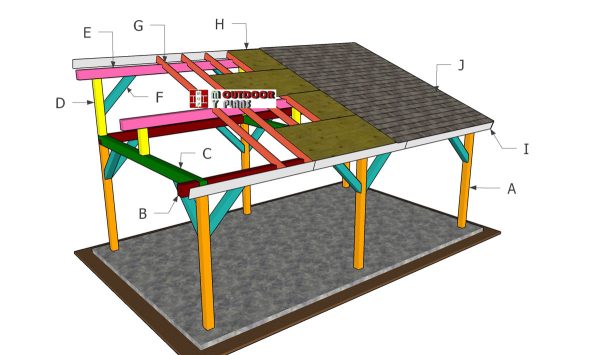
Building-a-14×24-lean-to-pavilion
Cut and Shopping Lists
Tools
![]() Hammer, Tape measure, Framing square, Level
Hammer, Tape measure, Framing square, Level
![]() Miter saw, Drill machinery, Screwdriver, Sander
Miter saw, Drill machinery, Screwdriver, Sander
Time
Related
- PART 1: 14×24 Pavilion Plans
- PART 2: 14×24 Lean to Pavilion Roof Plans
How to build a 14×24 pavilion
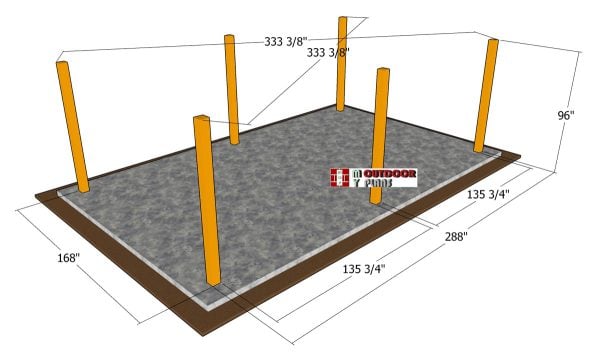
Laying-out-the-posts
First, layout the posts for the outdoor lean to pavilion. Use batter boards and string to determine the location of the posts. Apply the 3-4-5 rule to every corner of the pavilion, so you make sure they are right angled. Make sure the diagonals are equal and make adjustments, if required.
Determining the location for the pavilion is important, as you have to comply with the local building codes, and it will set the base for the rest of the project.
To prepare the land for building a pavilion, start by clearing the site of vegetation, debris, and obstructions, then proceed to level the ground, ensuring a flat and even surface for the pavilion’s foundation, and finally mark the boundaries to establish the precise dimensions for the construction.
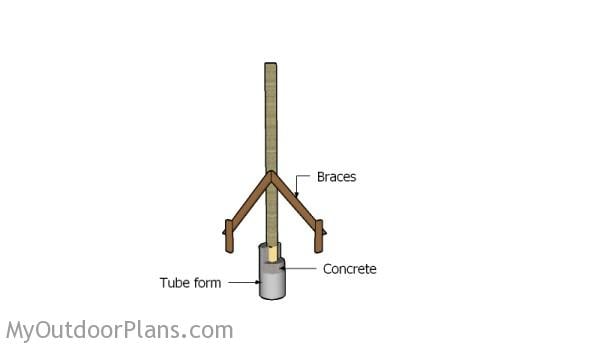
Setting the posts in concrete
Dig 3 ft holes into the ground, making sure they have about 14″ in diameter. Fit the tubes then the posts into the ground and plumb them with a spirit level. Fit the anchors and align them, then let the concrete dry out for several days. Read the local codes for more details on how to secure the posts.
Use lag screws to secure the posts to the anchors. Before pouring the concrete you need to make sure the top of the posts are horizontal one to another. Use a laser to mark the level to the top of the posts and use a circular saw, if you need to make cuts.
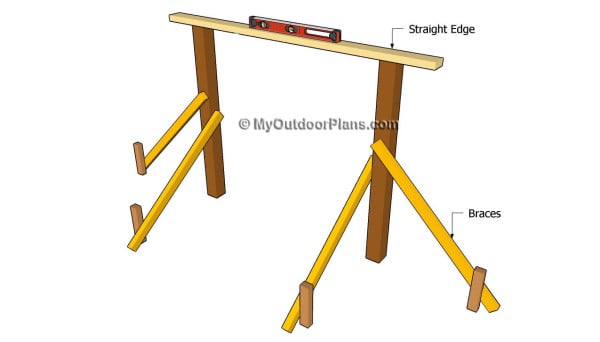
Installing the posts
After setting the posts into place, check if they are level and user a circular saw to make corrections. Notice the temporarily braces that hold the posts plumb. Leave the braces into place until you finish the assembly of the pergola. The temporarily braces will give support to the structure.
Now is the time when you can also adjust the height of the posts. If 8 ft is too tall for your needs, you can make them 7 ft, for example.
Building the frame of the pavilion
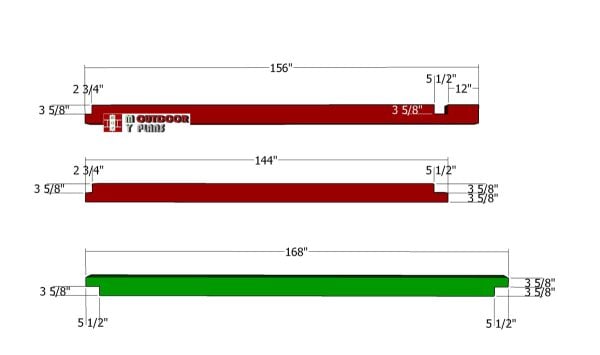
Top-plates
Next, we will be building the top plates for the lean to pavilion. Therefore, this pavilion requires 6×8 lumber, due to the large spans on the front and back. As you can see in the diagram, you need to make 3 5/8″ notches to the beams, so you can lock them together tightly.
Use a circular saw to make parallel cuts inside the marked areas and remove the excess with a chisel. Smooth the recesses with sandpaper.
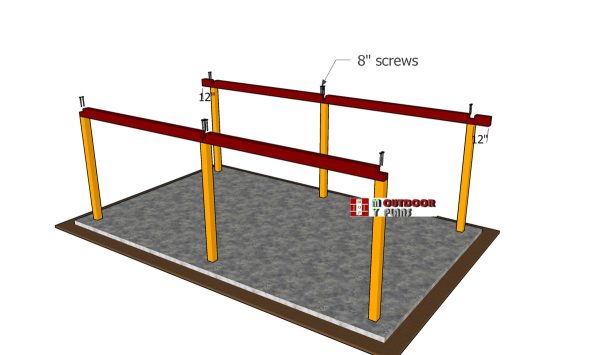
Fitting-the-top-plates
Position the beams horizontally on top of the posts, ensuring they are level and evenly spaced. Secure the beams by pre-drilling pilot holes and using screws or bolts to fasten them to the posts. Check the stability and levelness of the structure, making necessary adjustments.
Repeat the process for each additional beam, maintaining proper spacing and alignment. This process will result in a secure and stable framework for your pavilion. Notice the 12″ overhangs to the back of the pavilion. Drill pilot holes through the plates and insert 8″ screws to lock them to the posts. Use 2 screws for each joint. Make sure the corners are square and plumb the posts vertically.

Fitting-the-crossbeams
Next, fit the cross plates to the pavilion. Align the edges flush and drill pilot holes. Insert the 8″ screws to lock the cross plates into place tightly.
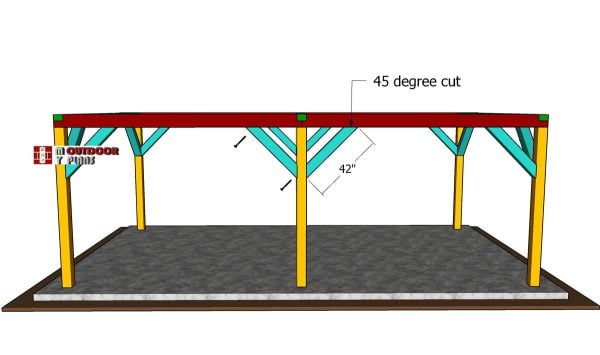
Fitting-the-braces
To attach diagonal braces to a pavilion for added stability, begin by determining the appropriate placement for the braces, typically at corners or where additional support is needed. Measure and cut the braces to the required length, allowing for some overlap at the connection points. Position the first brace diagonally between two structural members, aligning it from the bottom of one post to the top of the opposite post. Secure the brace by pre-drilling pilot holes and using 5 1/2″ screws or bolts to firmly attach it to the posts.
Repeat the process for each diagonal brace, ensuring a tight and secure connection. Finally, check the stability of the pavilion and make any necessary adjustments to ensure the braces provide the desired support. By following these steps, you can enhance the stability and durability of your pavilion with diagonal braces.
Framing the roof structure
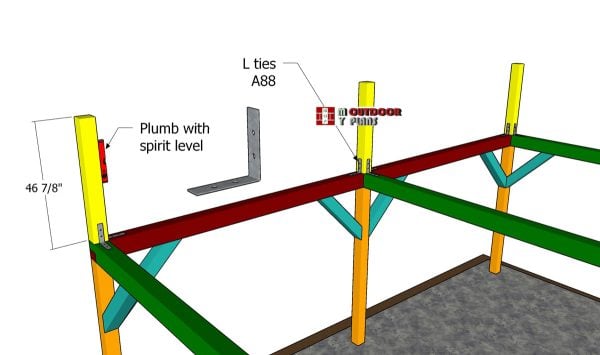
Fitting-top-ridge-beam-supports
Fit the 6×6 supports to the top of pavilion. Plumb the supports with a spirit level. Use L tie connectors to secure the each support to the frame of the pavilion (2 for the end supports, 3 for the middle support). Insert 1 1/2″ structural screws to lock the beams together tightly, using the connector.
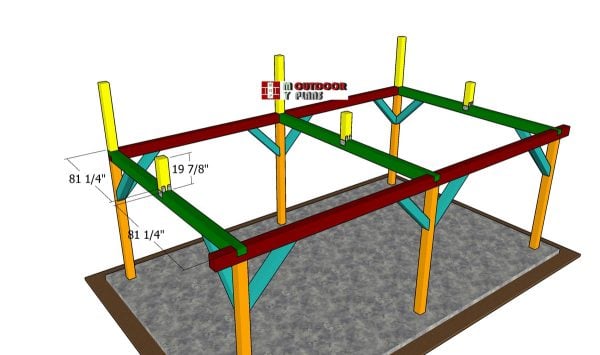
Fitting-the middle-ridge-beams-support
Use post to beam connectors to secure the middle supports to the frame of the pavilion. Make sure you center the supports to the crossbeams, as shown in the diagram. Insert 1 1/2″ structural screws to lock everything together tightly.

Fitting-the-ridge-beams
Fit the 6×8 beams to the top of the supports. Notice the 12″ overhangs to the front and back of the pavilion. Use post to beam connectors with 1 1/2″ structural screws to lock everything together tightly. Insert 1 1/2″ structural screws through the connector. Make sure the corners are square and align the edges flush.

Fitting-the-top-braces
Use 6×6 lumber for the braces. Make 45 degree cuts at both ends of the braces. Secure the braces into place with 5 1/2″ screws. Drill pilot holes before inserting the screws. Use at least 2 screws for each joint. These braces will really reinforce the structure and add extra-support to the ridge beams.
Finishing touches

14×24 lean to Pavilion Plans
Check out PART 2 of the project to learn how to build the lean to roof. A backyard pavilion is more than just a project; it’s an investment in creating a versatile and enchanting space that enhances your outdoor living experience and adds value to your property.

14×24 lean to Pavilion Plans – side view
On average, a DIY pavilion project can save you anywhere from 20% to 50% or even more compared to buying a pre-made pavilion. By sourcing your own materials, taking advantage of sales and discounts, and utilizing your time, tools and skills, you have the opportunity to reduce the costs and keep extra money in your pocket.
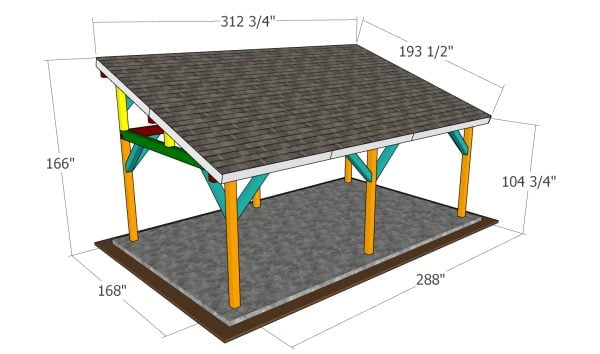
14×24 lean to Pavilion Plans – dimensions
Fill the holes with wood putty and let them dry out for a few hours. Smooth the surface with 100-220 grit sandpaper and remove the residues with a damp cloth. See the overall dimensions of the project in the above image.
Top Tip: Apply a few coats of paint or stain to the components, to enhance the look of the project. Check out the Shop, as well, for full list of Premium Plans.
This woodworking project was about 14×24 lean to pavilion plans free. Thank you for joining me on this exploration of lean-to pavilion plans. I look forward to welcoming you back to my blog, where architectural plans await at every turn. Until then, may your imagination soar and my designs take shape through your work. Happy building!


